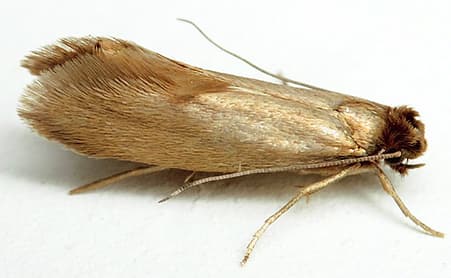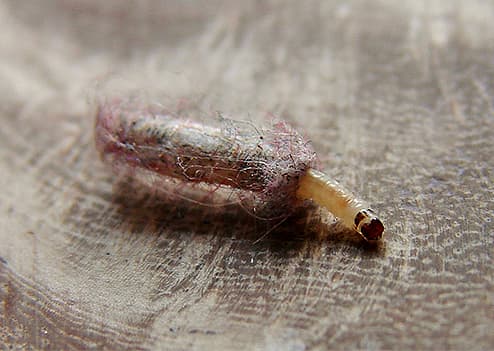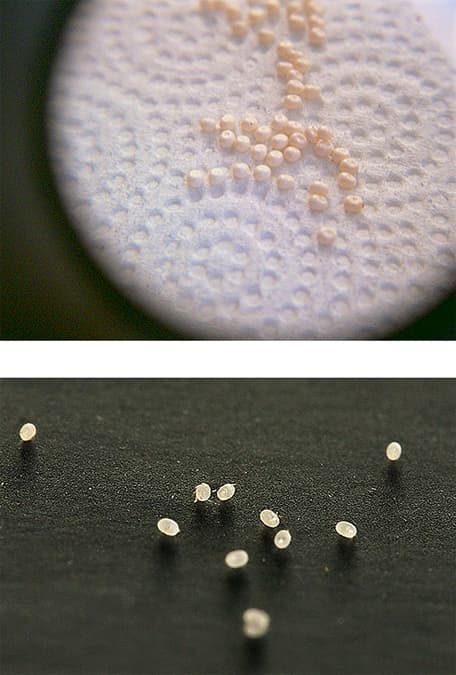Effective against the worst enemy of clothing - clothes moth (Tineola bisselliella). The trap powerfully attracts butterflies. Once they land on the surface, they stick and die, which helps prevent the appearance of caterpillars that feed on clothing fabric.
Application: remove the protective sheet, fold the house along the indicated fold lines and place the trap where clothes moths are most likely to appear: cabinets, wardrobes, mezzanines, etc.
Place traps when you notice the first flying butterflies. Recommended number of traps: 1-2 pcs. for one room. To achieve maximum effect, it is recommended to change them every 2 months. Traps should be changed more often if they become heavily clogged with captured moths or dust.
Store in a dry and cool place, out of the reach of children.
Empty packaging and remaining product can be disposed of as household waste.
Ingredients: cardboard, sticky substance.
Shelf-life Unlimited.
Packing: 1 pc.

Tineola bisselliella.

Tineola bisselliella.
* Clothes and furniture moths have long been “popular” for their vital activity: they spoil clothes, fur and wool products, furniture upholstery and carpets...
At the same time, the furniture moth prefers fur, furs and wool, and the clothes moth prefers mainly cotton products.
In nature, both species are pronounced keratophages, that is, they feed on the hair and feathers of animals, and in an apartment, they can easily switch from one diet to another.
In the past, both of these types of indoor moths were called collectively - “clothes moths”, and even today this habit has been preserved among ordinary consumers, although the butterflies themselves are quite easily distinguished from each other. Therefore, in the future in text, when describing the general features of biology, both species will be called clothes moths, and if clarification is required, this will be discussed separately.
Both types of moths are quite similar to each other. Adult butterflies are small - they reach 5-9 mm in length with folded wings and have an inconspicuous straw-yellow colour.
Clothes moth (Tineola bisselliella) - almost always light yellow. It is difficult to discern the differences between these species with the naked eye.
The furniture moth (Tineola furciferella) can be somewhat darker and has slight darkening at the base of the wings.
Furniture moths are not easy to distinguish from clothes moths. In the air, the furniture moth looks like a small moth that is not the most skilled in flight, and only males fly in both furniture and clothes moths. Females have wings, but they do not use them.
But the most important pest is not the moth. The immediate destroyer of clothing and furniture upholstery are clothes moth larvae - inconspicuous small caterpillars that carefully and quite quickly gnaw holes in sweaters, paths on fur coats and bald patches on carpets.
Moth larva and eggs: how and where to find them.
So, it is the moth larva that feeds on our clothes. From wool and cotton, the caterpillar is able to extract the minimum nutrients that are there, and for this it has all the necessary devices: fairly strong and long mandibles - two large projections that act as scissors for cutting fabric fibres and fur hairs. Each of them has several teeth that increase the gnawing capabilities of the caterpillar. Powerful jaw muscles (almost the entire head), thanks to which the caterpillar can develop sufficient pressure to gnaw on matter. Thanks to their well-developed oral apparatus, the larvae of furniture and clothes moths actively eat fabric fibres. Huge, compared to the size of the body, stomach and intestines, in which large amounts of food can accumulate. At the same time, the larvae of furniture moths are clearly distinguished from the larvae of clothes moths. The larva of a clothes moth can build a simple small case from its own secretions and food debris, while the caterpillar of a furniture moth builds a clearly visible and durable corridor along its entire route of movement, visible to the naked eye.
It retains this whitish-yellow colour throughout its entire development: The clothes moth larva weaves a cocoon from its own secretions and fibres of damaged tissue.
House moth caterpillars are quite inactive. Only after hatching from the eggs, they spread to short distances from each other, but after they begin to feed fully, they move very little.
If the food is quite suitable for the larvae of house moths (contains little or no synthetics), then they grow quickly, and in 18-20 days they manage to molt 12-13 times, after which they pupate. If the caterpillars have to eat low-nutrient food (for example, with a high content of indigestible synthetic fibres), then in most cases development is delayed up to 1-2, and sometimes up to 6 months.
* Furniture moths are distinguished by their striking golden colour. The head is yellow. The bases of the upper wings are dark red. The species was formed not only due to the way of life, but also due to the special structure of the body: the head is equipped with peculiar labial tentacles.
Furniture moths eat furniture, starting with the fluffy stuffing. And only when approaching pupation, the larvae climb to the surface of the furniture, where they continue to destroy the material. Interestingly, at the same time they move according to the pattern on the fabric.
Pupation occurs, as a rule, on the lower surface of armchairs, sofas or chairs. If you look there some time after the home has been infested, you can stumble upon large nests filled with light-coloured pupae.
In the cold season, the larval stage lasts up to six months, but in the summer this process takes only a couple of months. Pupation begins at the end of winter. Departure occurs during all three spring months. Repeated flight occurs in the second and third months of summer.
.jpg)
Tineola furciferella.

Tineola bisselliella eggs.
Note: the development of house moth larvae slows down even if the air temperature in the place where they are present decreases. At the same time, the caterpillars themselves become smaller, and when certain temperatures are reached, they hide in cocoons and stop feeding. The eggs of indoor moth species are white or whitish-yellow, small and do not exceed 0.5 mm in length. The female lays them in small groups of 50-80 pieces directly on clothing or other fabric, which the larvae will subsequently feed on.
* The eggs of clothes and furniture moths develop within 5-6 days, but when the air temperature drops, this period is delayed, and when they reach 0°C, the eggs die altogether.
Moth nutrition and the main harm from it.
Adult clothes moth butterflies do not feed at all, since their mouthparts and digestive tract are underdeveloped, and they do not need food. (By the way, moths live no more than a few weeks, and most often - 8-10 days). Typically, females lay eggs already on the third or fourth day after emerging from the pupa, after which they die quite quickly. Moth larvae feed almost in the same place where they hatch from eggs. Any natural fabric, fur, wool is suitable for them as food; they often parasitize on museum stuffed animals and in warehouses of textile raw materials: any natural material is suitable as food for clothes moth larvae...
Moth larvae that feed on fur items cannot move unhindered in the wool, so they have to gnaw on fur hairs along the way of their movement, which they do not eat, leaving a clipped path and a bunch of hairs on the clothes...
Moth caterpillars cannot feed on completely synthetic things. If the fabric consists partly of synthetics, then it can be eaten by the larva, but on such a diet the caterpillar grows much slower than on natural fabrics.
Reproduction and lifestyle of the pest.
Having emerged from the pupa, male clothes moths begin to diligently search for a female, guided primarily by smell. After mating, within 3-4 hours, the female begins to lay eggs. She lays them in portions, while the furniture moth is much more prolific - one female can lay up to 300 eggs, while for a female clothes moth this number barely reaches 60. The clothes moth has no seasonality in development and reproduction. Larvae from the same clutch can develop at different speeds, and the emergence of butterflies from the larvae occurs unevenly and scatteredly. In nature, all species of mid-latitude moths have a period of hibernation: pupae or caterpillars of the last instars usually overwinter.
Fighting moths: are there really reliable means?
Today there are a large number of ways to get rid of clothes moths, both traditional and quite modern. The most effective among them are the following:
* treatment of clothing with insecticidal preparations in aerosol form. Such means allow you to quickly destroy larvae and butterflies at any time of the year.
* freezing infected clothing and furniture outdoors at temperatures below minus -5°C, or heating it in the sun on a hot summer day with preliminary thorough shaking out, because the larvae do not stick well to the surface of clothing and easily fall off.
* washing clothes at the maximum permissible temperatures.
* use of insecticidal fumigators and glue traps installed in cabinets
* in addition, strong-smelling herbs are used to protect cabinets and wardrobes from moths - tansy, lavender, rosemary, as well as orange peels, tobacco
* special, industrially produced, moth sections with various odors (laid out in cabinets, they can reliably repel adult butterflies). It is important to understand that such odorous products do not affect the larvae.
* the most reliable way to prevent moths from multiplying on things is a thorough quarantine: checking new purchases, thoroughly washing new clothes at high temperatures and avoiding shopping at second-hand stores: it is always easier to prevent a pest from appearing in an apartment than to get rid of it later!
Interesting Facts:
* Among the moths there is a butterfly whose caterpillars gnaw holes in the horns of African antelopes and live in them, feeding on keratin.
* The opinion that female house moths are wingless is not true. Any indoor moth has winged females and males. The wings of females are only slightly smaller than the wings of males, and in principle, females are capable of flight. But this ability is not used as unnecessary, since the males themselves find and fertilize them, and the females lay eggs without long distance movements.
* Clothes moth caterpillars diligently avoid light: if you bring clothes with them into the light, they hide among the folds of the material or in their covers.












